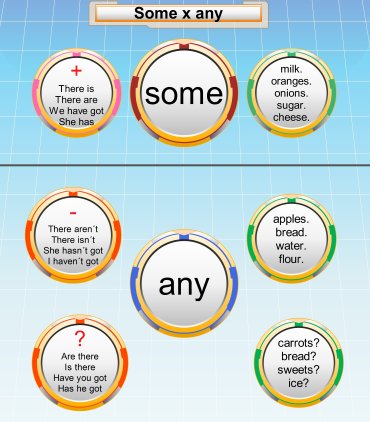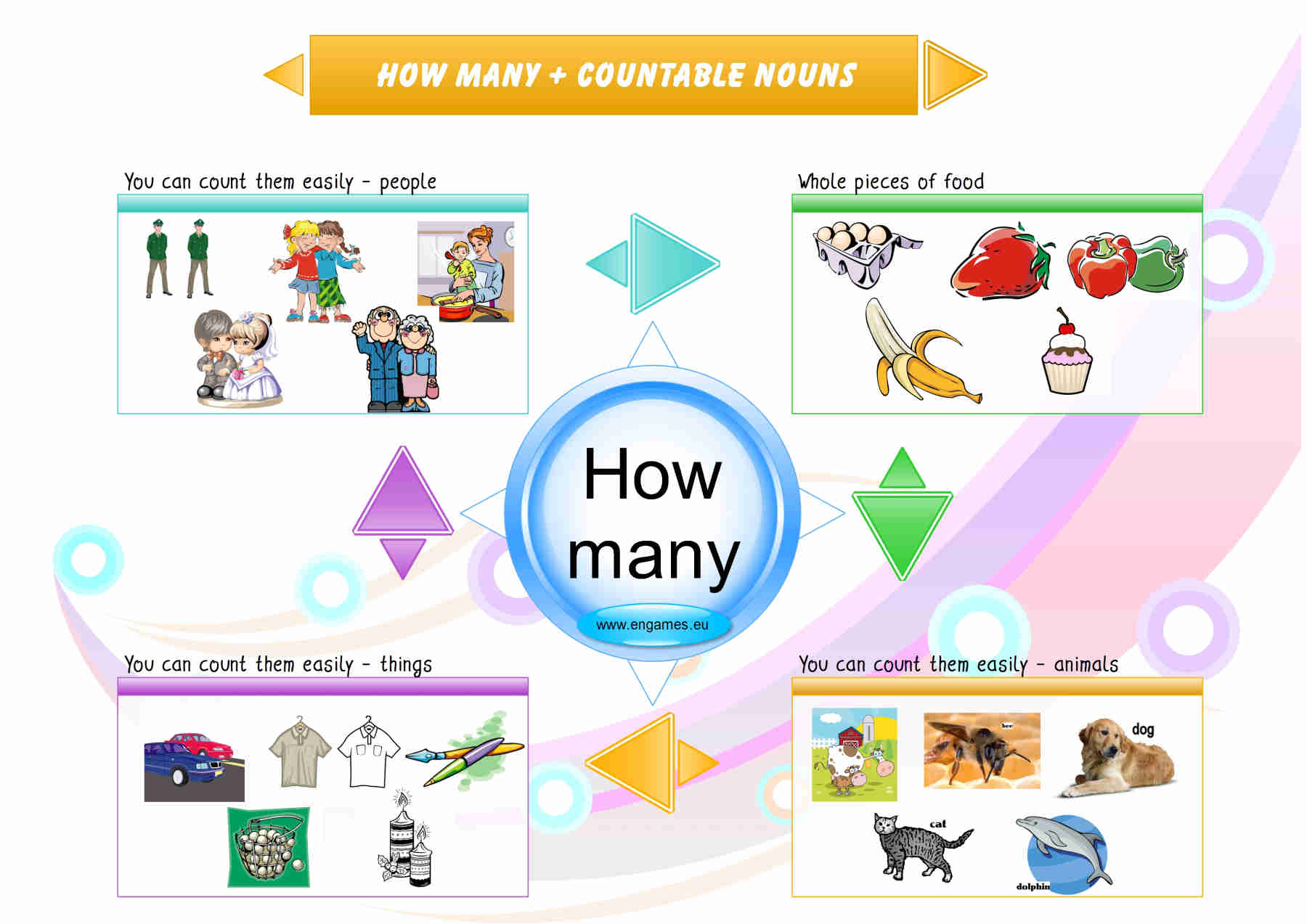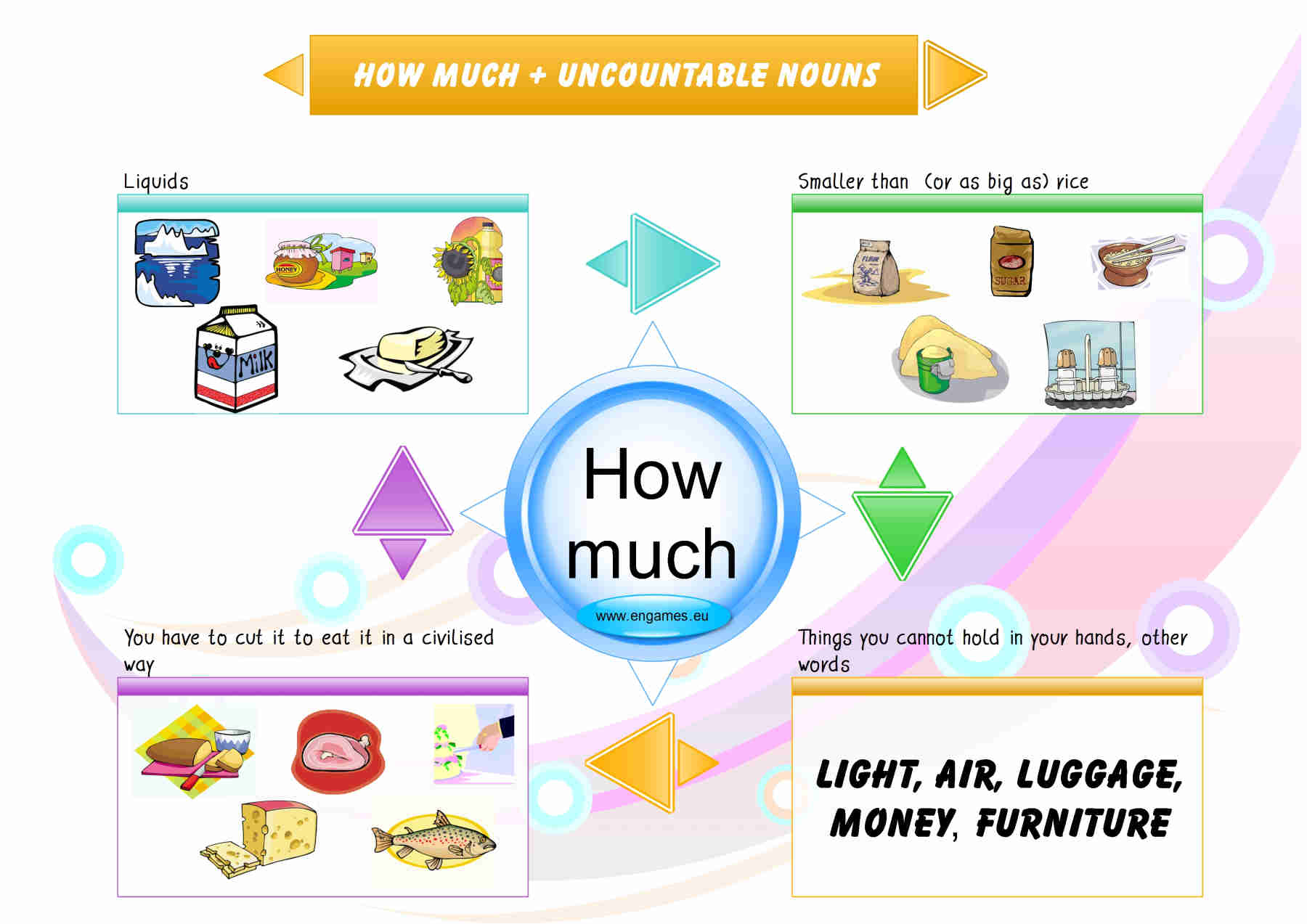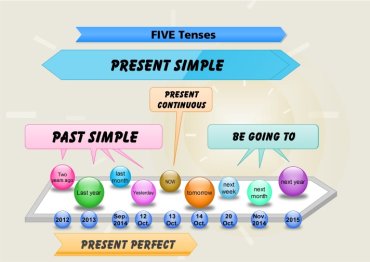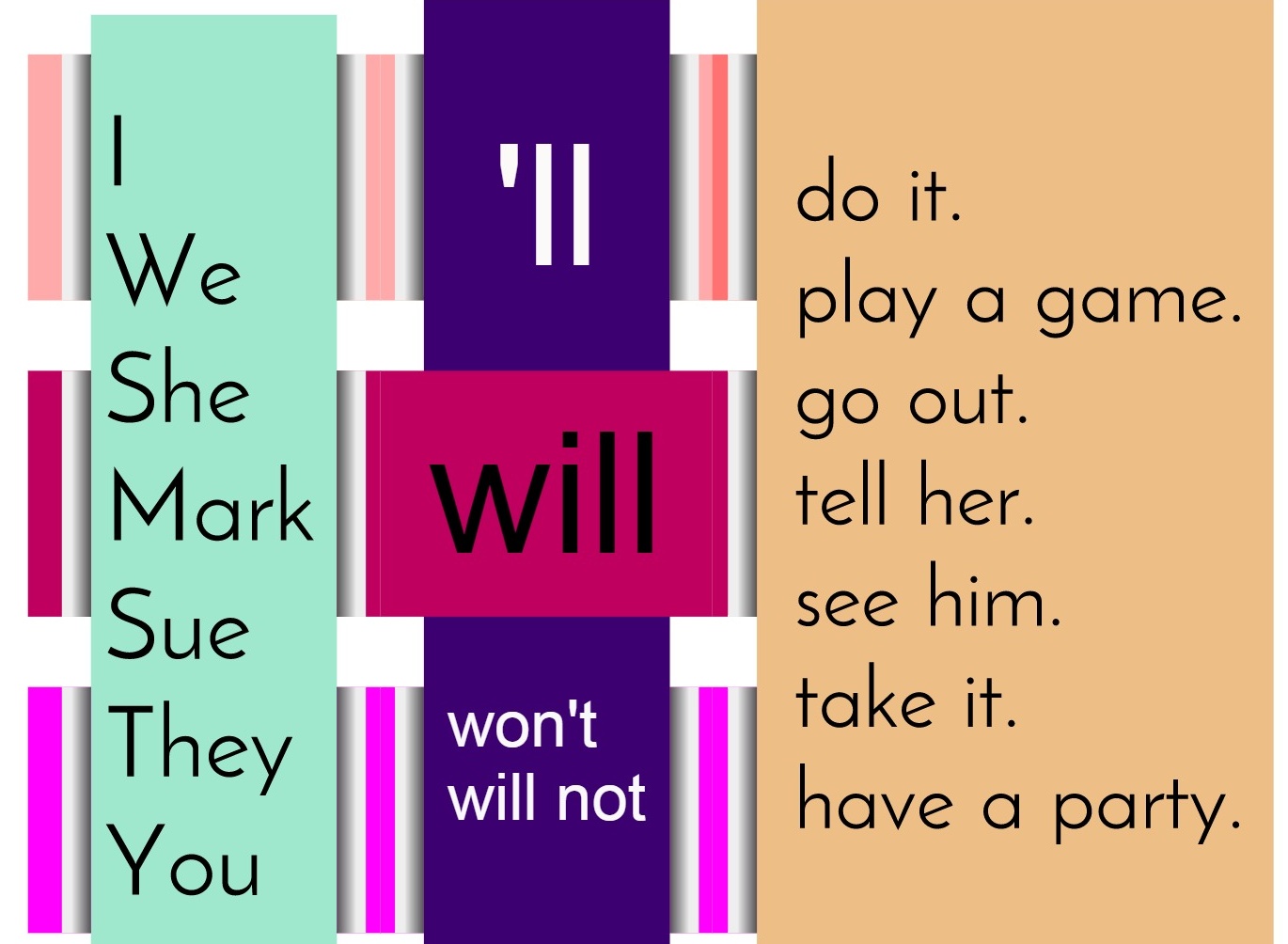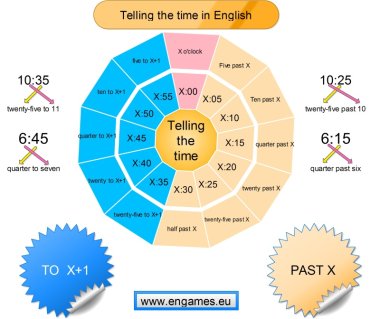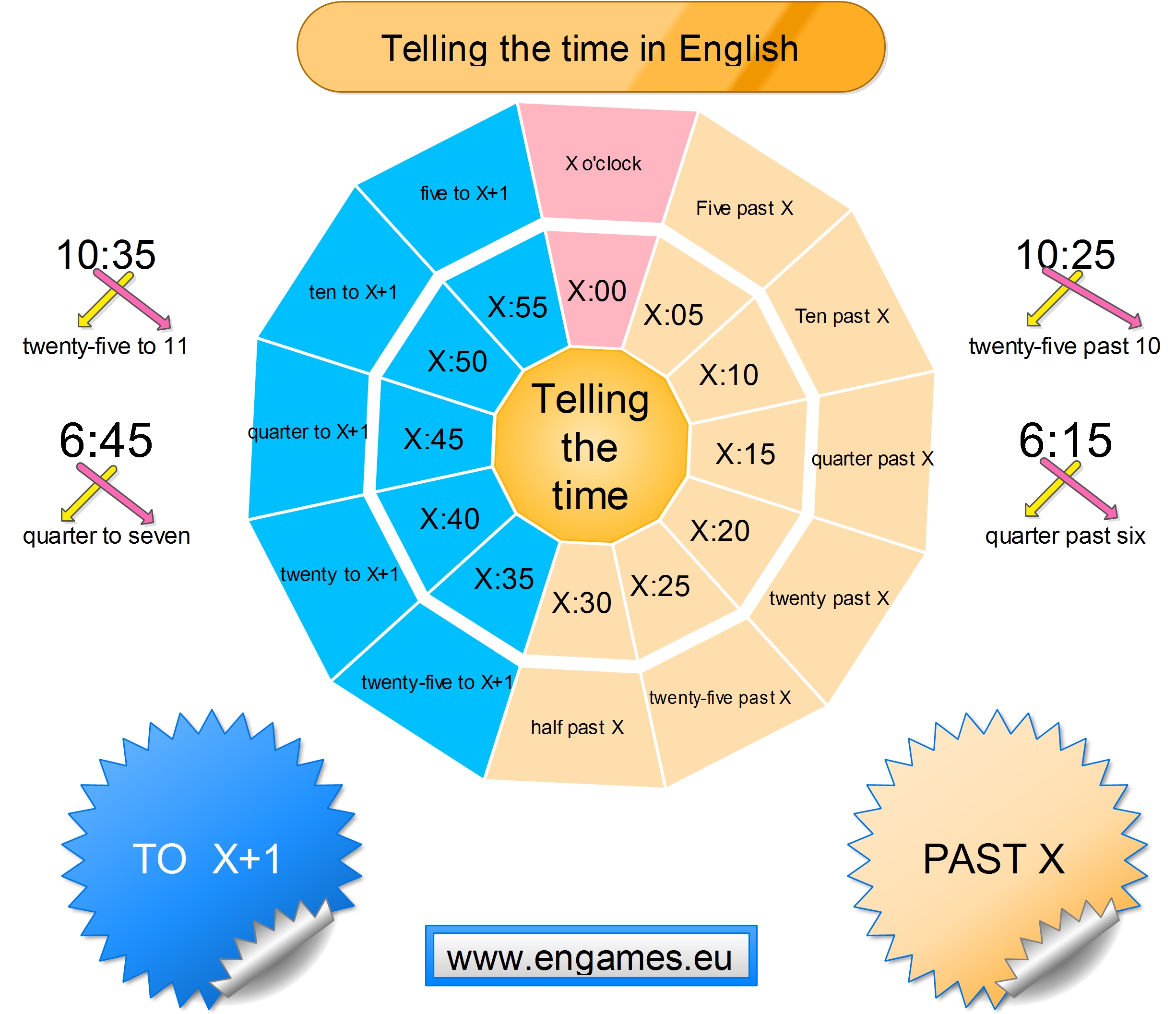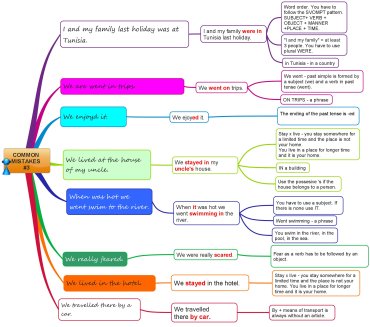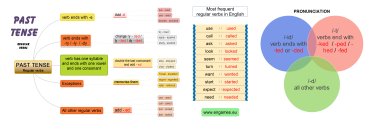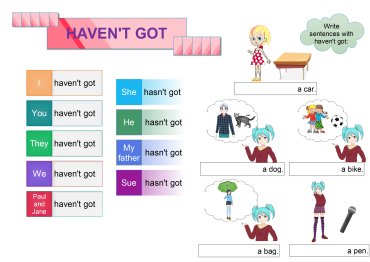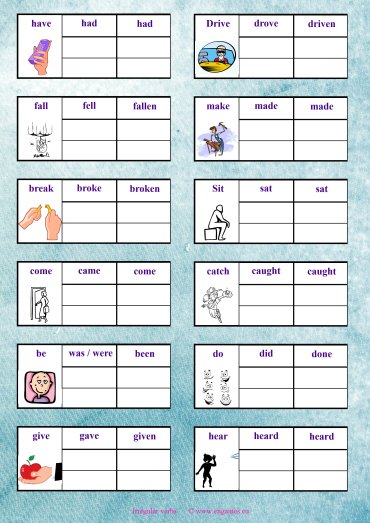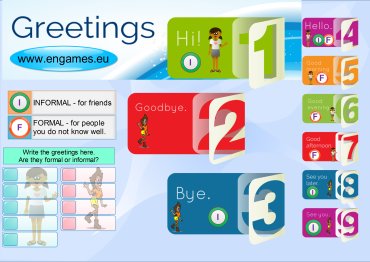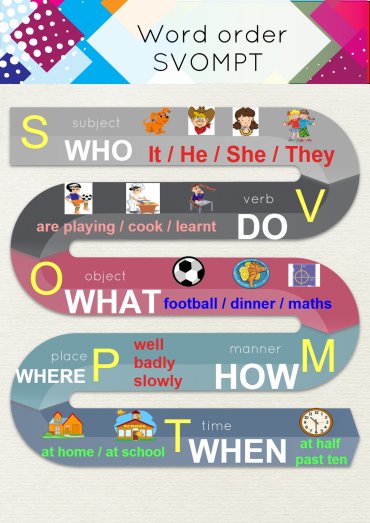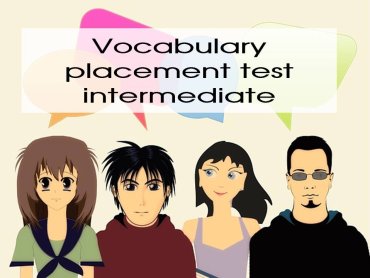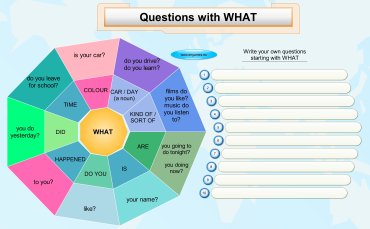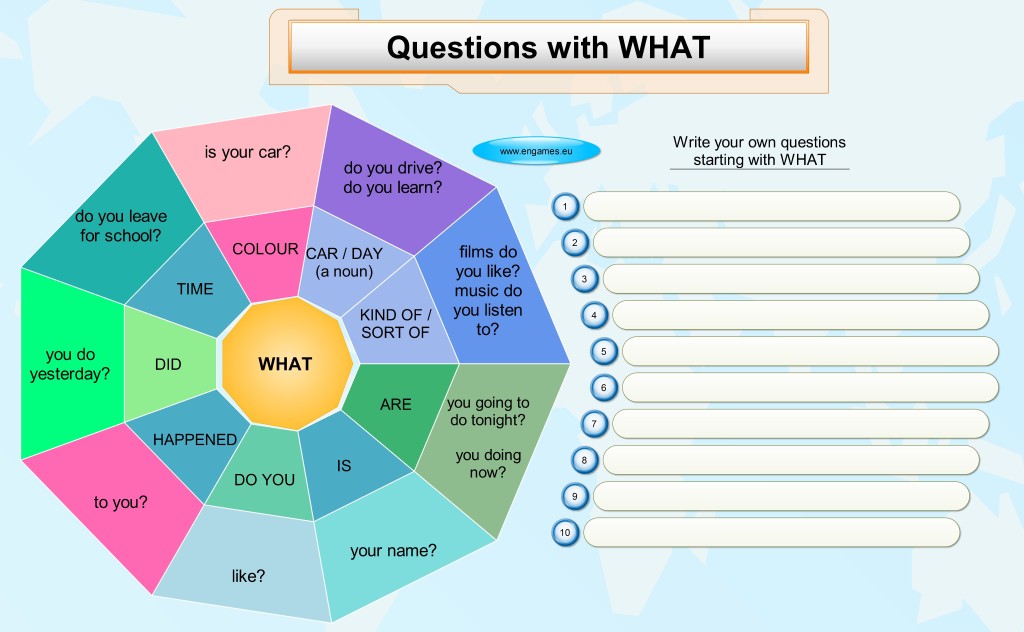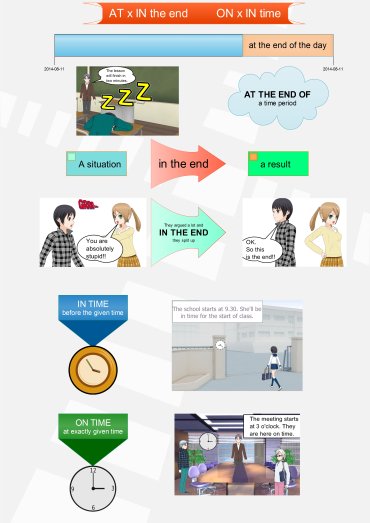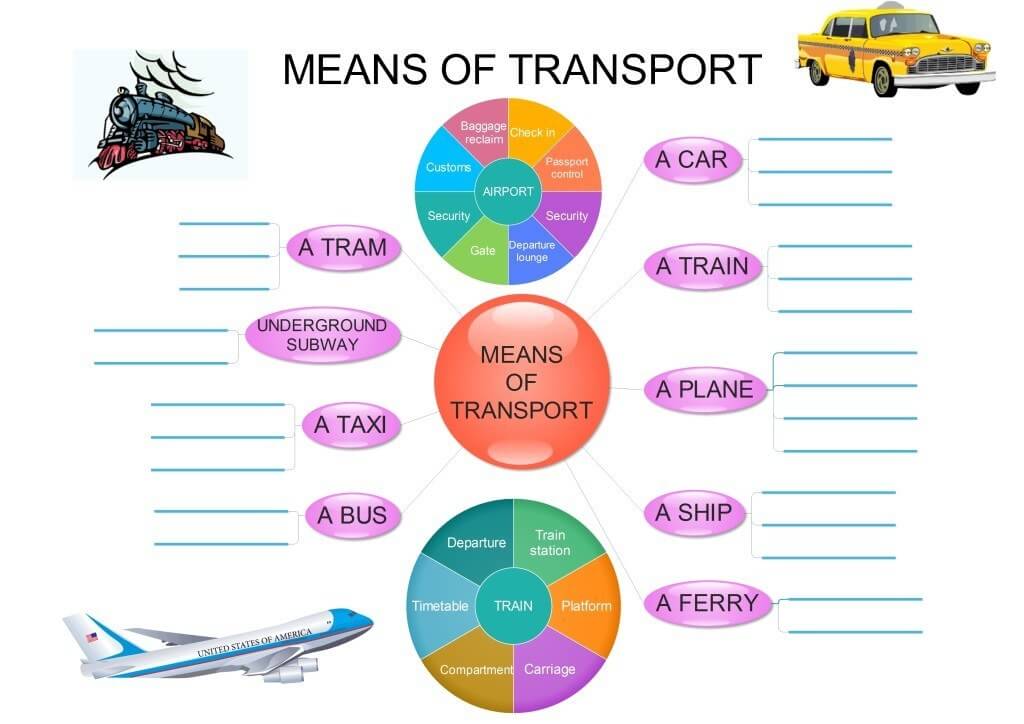The usage of the words SOME and ANY is really easy. However, some textbooks like to mix this grammar with the concept of countability and thus they confuse the students. These two words have very little to do with countability. In my opinion their usage is dependent on completely different factors.
In this post I would like to show how I teach the usage of SOME and ANY. There is an infographic to help me and several exercises to practise this grammar.
ADVERT:
[showmyads]
Some and Any – infographics
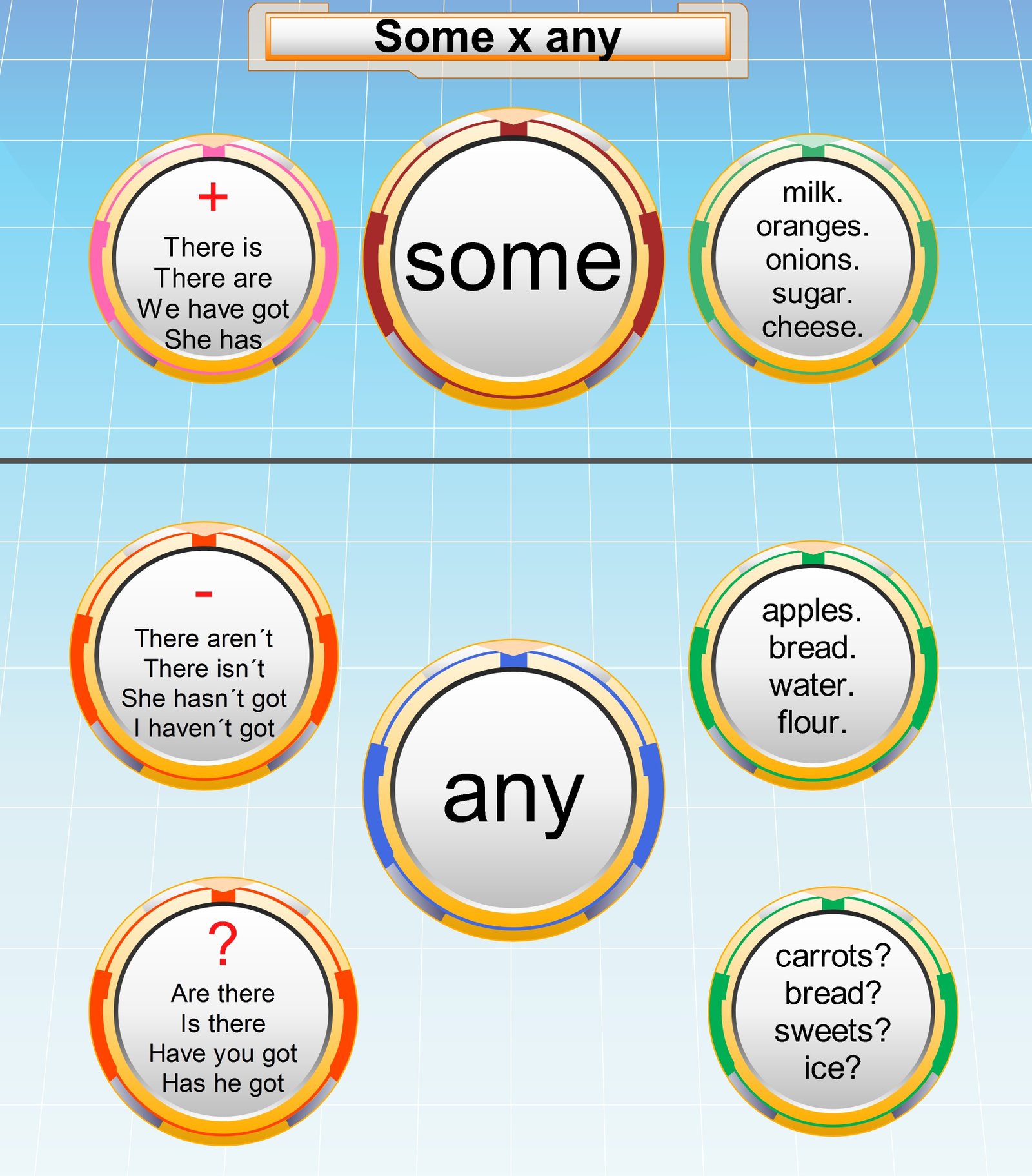
Once I elicit the usage of the two words, I verify the students knowledge with the following exercises and games.
Some and Any – exercises and games
The first quiz is created in HTML 5 so it will play on all mobile devices. It is not a bad idea to ask your students from time to time to use their mobiles and do the exercise online. They will feel happy that they can use their mobile phones or tablets at school.
Some and Any quiz – full screen
The second game is called On target and students at school love it. Your aim is to choose the correct answer and then shoot as many bad ducks as possible. Moreover, you can get a bonus if you shoot one of the bottles on the side. This game is in flash and therefore will work only on desktops.
Some and Any quiz – full screen
If you do not have an interactive whiteboard at school, you will appreciate the print version of the quiz:
If you feel that there are not enough exercises at this site you can visit British Council site and learn more about SOME and ANY there.
Blog competition
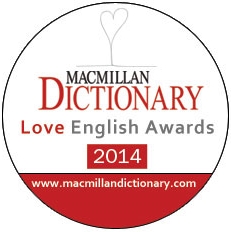 Macmillan publishing house runs a competition Love English Awards and as this site has been nominated, you can vote for us here. Thank you for your support.
Macmillan publishing house runs a competition Love English Awards and as this site has been nominated, you can vote for us here. Thank you for your support.
How much and How many – share
The post on countability has been the seventh most viewed post at our site. More nearly 95,000 people have seen it and hopefully used it. While the post is great for intermediate students of English, it is very theoretical. This post aims to be more practical and for a bit lower level of students. Here I would like to teach the usage of HOW MUCH and HOW MANY using as few words as possible.
To achieve this there are two games and a mind map. I hope you will find the post useful and practical.
How much and How many – mind map
How much and How many – mind map
The second game is called En Garde and your task is to answer correctly and then inflict as much damage to your opponent as possible. Enjoy.
The first game is called Penalty ShootOut. If you choose the correct answer you are given a chance to kick a penalty. Good luck
Blog competition
 Macmillan publishing house runs a competition Love English Awards and as this site has been nominated, you can vote for us here. Thank you for your support.
Macmillan publishing house runs a competition Love English Awards and as this site has been nominated, you can vote for us here. Thank you for your support.
How much and How many – share
The games How much and How many
About half a year ago I published a post where I tried to explain the usage of 5 different tenses. About 71,000 people have viewed this post but several complained that there was not enough practice. That is why I have decided to reintroduce this topic and add three more quizzes to practise the five tenses. So here we go!
Five tenses – mind map
ADVERT:
[showmyads]
And if you think you understand the grammar, it is time to try the quiz.
Five tenses – quiz
You can download the word document here and you can edit it in any way you like. The key is included.
If you prefer the interactive version of the same quiz, you can find it down here.
If you would like to do more practice, you can go to British Council site and try several more exercises there.
There are many different ways to speak about the future in English. You can find all of them in the previous posts on future tenses at Will or be going to or at Be going to post. In this post I would like to explain and teach the usage of WILL for speaking about the future. You are going to find a mind map, a story about WILL and several interactive exercises here. I hope you will find this post useful.
Will for the future – mind map
ADVERT:
[showmyads]
Once you present the form of the verb WILL it is time to explain the usage. I prefer using stories when explaining the grammar. I do it this way because stories are more memorable than just a simple explanation. You can create your own story or you can use mine. If you are afraid that your students´ English is not good enough you can tell the story in their Mother tongue.
The story about WILL
He looked like a normal boy but he wasn’t. He irritated people with his behaviour. He simply talked too much
For example when he was at school he always wanted to help other people. But while other children helped without any words WILL always spoke.
“I, Will, help you, sir,” he shouted when he saw the teacher carrying a lot of things.
“I, Will, clean the board,” he jumped up another time.
Of course, his friends did not like it and soon they started to say ironically.
“I will do it.” or “She will do it.”
As I say, Will talked too much. And he liked talking about his opinions.
“I think …” were his favourite words. And as children did not like him they soon parroted.
“He thinks it WILL rain.” “I think I WILL earn a lot of money.“
And one day another strange thing happened. Will’s eyes went big and he started to predict the future.
“There be people on the Moon. We fly to Mars.”
But children did not believe him and they laughed even more.
“There WILL BE people on the Moon. We WILL fly to Mars,” they screamed all over the school.
Nowadays no one remembers Will or his behaviour at school but ever since people still say “I will do it,” when they decide at the moment of speaking to help anyone.
We still say “I think she will fail.” when we express our opinions about the future.
And when we predict something we say “People will not use tablets in 10 years time.”
No one remembers the nerd WILL but his name is there in the sentences.
WILL for the future – practice
You can watch a bit different video explanation the usage of the will form here:
Once you think your students understand the grammar you can try the following quiz:
WILL for the future – leave a comment and learn
WHAT DO YOU THINK THAT WILL HAPPEN IN THE YEAR 2015.
Write your opinions into the comments and I will correct them and inform you about your grammar.
WILL for the future – share
If you do not have the internet connection in the classroom you can download the quiz and presentation here. Moreover, you can place these at your blog or website 🙂
ADVERT:
[showmyadsa]
Please rate this post below. Our previous post on adverbs of Frequency scored 4.49 stars. Do you think this one is better?
Telling the time is something I have to teach every year. And to be honest I have not been very successful. Even gifted adults struggled.
And this year I faced even bigger challenge. I was supposed to teach this to a group of challenged children who cannot tell the time in their MT. So I prepared some new materials and … And I did it.
And here is how.
ADVERT:
[showmyads]
Telling time – mind map
Then I demonstrated telling the time in English using one of the PAST times. I told them that they have to start with the minutes and then add the clock. The WOW moment came and I was really happy. Then I showed them how to work with the blue phrases. They soon understood that they have to add 1 to the number of clocks.
Telling time – classroom activities
First, we played bingo. I dictated the times and the students crossed them out. The winner (3 times in a row) shouted Bingo.
Another variation of the same game is that the students tell the time. Ask each student to choose one time on his card and tell it. The others listen and if they have it on their cards they cross it out.
Telling the time – bingo cards
The other activity is a pair work. Each student gets a card and they dictate their times to their partner.
Telling time – computer activities
ADVERT:
[showmyadsa] Telling the time – listening In the second quiz students are asked to write the time correctly. Both quizzes are in HTML5 so they will play anywhere. Telling the time – produce
You can find another interesting game to practice language connected with time at British Council time.
Telling time – share
telling_the_time
The mistakes students make are ideal for learning. They are much more complicated than any mistakes in textbooks and it is more motivating to correct your own mistakes. Moreover, students often make mistakes in areas not covered by textbooks or covered on a place which is remote from the time when the student makes the mistake. That is why I collect my students’ mistakes and try to deal with them.
ADVERT:
[showmyads]
This collection of mistakes comes from my students´ essays about their last holidays. I hope that they will help you or your students avoid these mistakes in the future.
Common mistakes – mind map
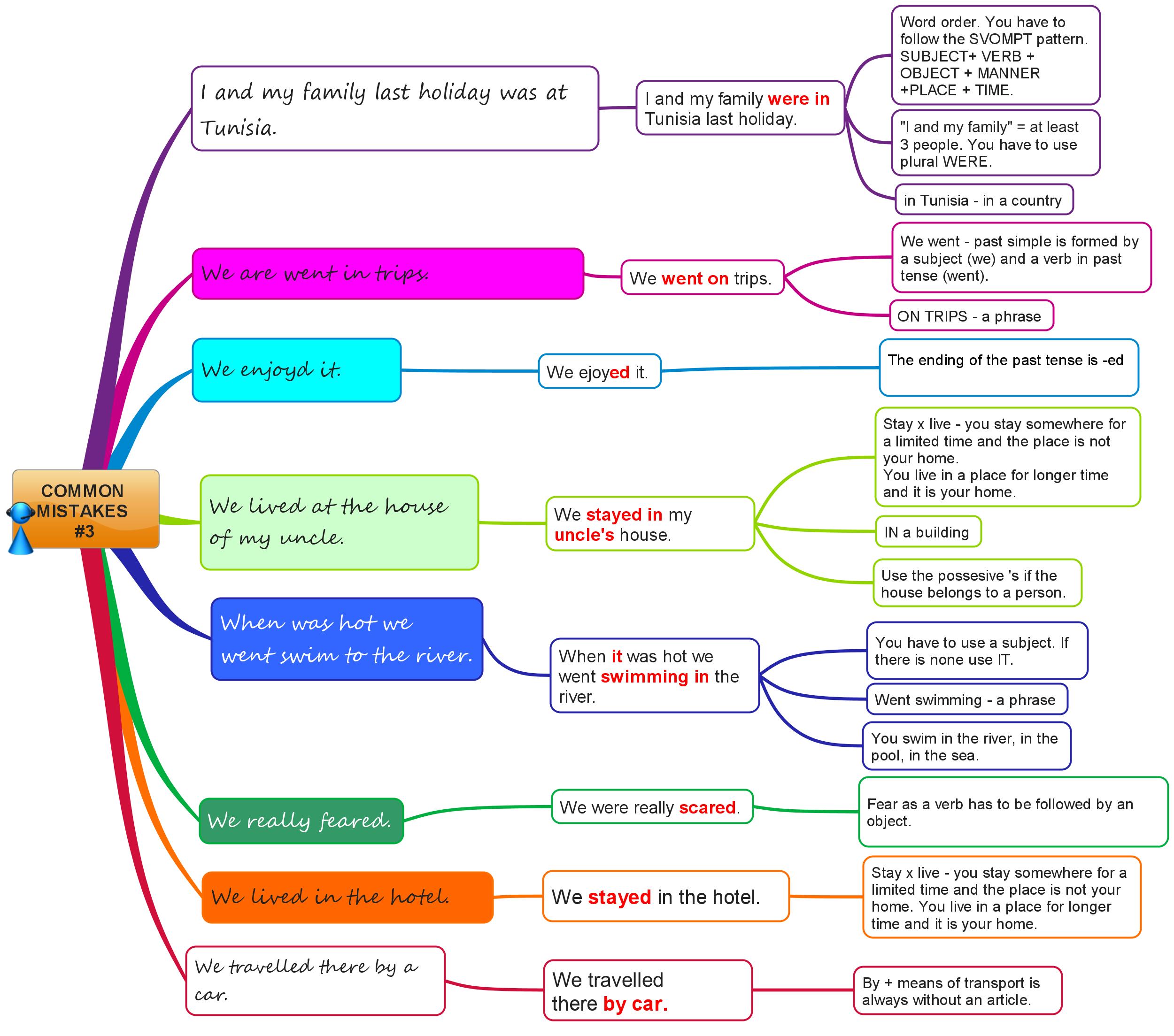
If you use this mind map in a classroom it might be a good idea to explain the mistake yourself and ask the students to fill in the explanations in their own words into the mind map below.
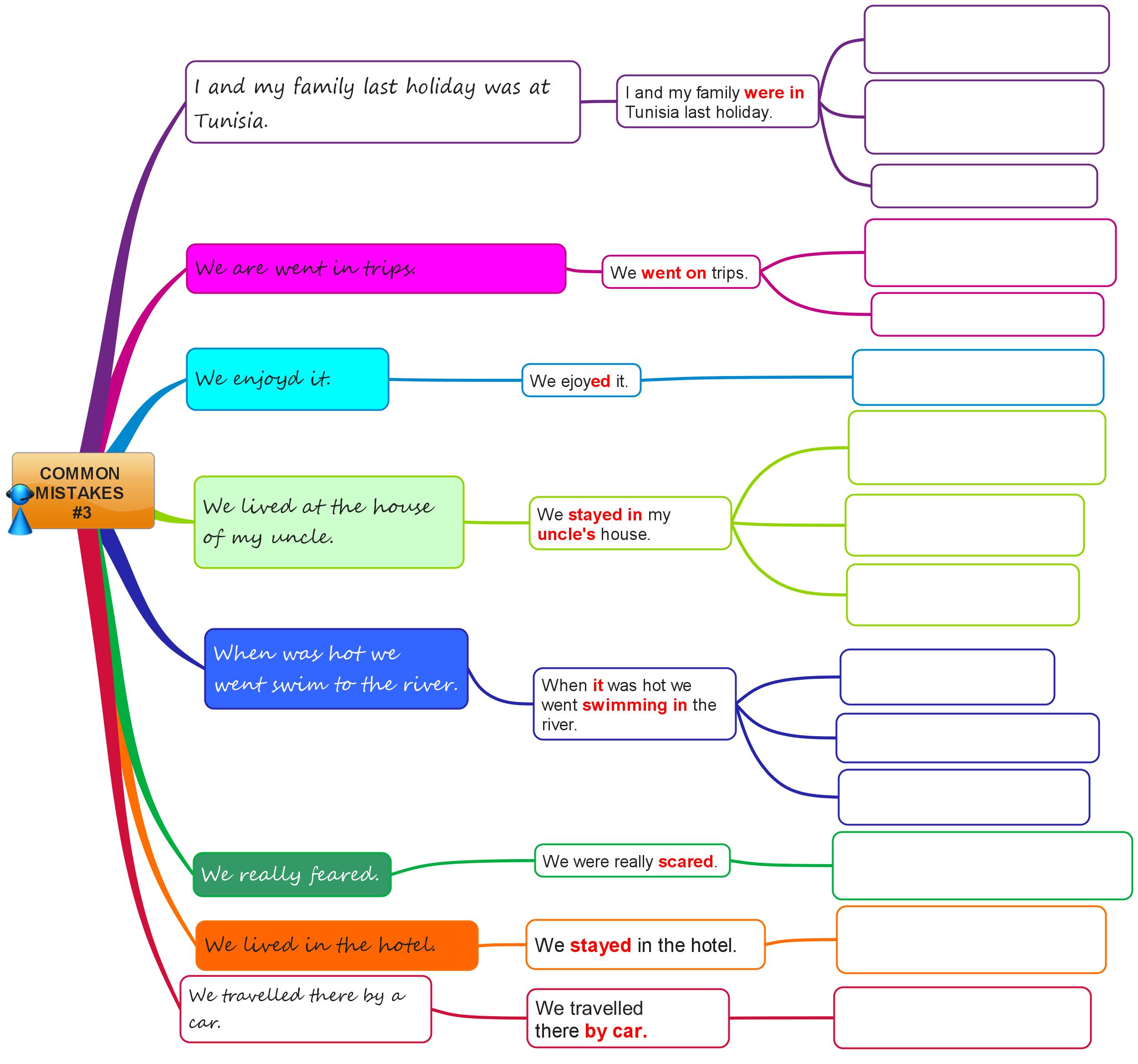
Common mistakes – games
Advert:
[showmyadsa] Common Mistakes Basketball The second games is a simple quiz. Answer the questions correctly and then play the game called Word boggle. All the answers are based on the mistakes from the mind maps above.
Common Mistakes Quiz
Common mistakes – Classroom ideas
Once most of the class have finished, I elicit the correct version of each sentence. It is a nice and really useful activity.
You can find some interesting activities connected to holidays at British Council pages.
If you prefer a game-like activities, there are several at British Council pages again.
Common mistakes – Share
In the last half a year I have taught this, in my opinion easy, piece of language and I have failed miserably in both cases. And on the basis of this failure I built this post. It contains a clear explanation in the form of a mind map, a worksheet and two games to practise the phrase.
Go and do something – mind map
ADVERT:
[showmyads]

Go and do something – games
The first game is in HTML5 and it will play on all mobile devices. Your task is to place the words into the correct gaps. If you pass the test, you can play the game called Make them Fall. Good luck 🙂 Go and do something – Make them fall game
The second game is in Flash and it will play just on your desktop. Your task is to click on the correct answer and then try to stop the circle in the middle of the basket.
Go and do something – HoopshootGo and do something – Share
If you like the games you can use them on your website or offline in your classroom. You can download the files here:
And the flash game is here:
If you share the files on your website, please, could you provide a link to this site? Thank you 🙂
I have already published several posts on past simple tense. There are several posts on irregular verbs, a post on regular verbs in past tense and now I would like to explain how to make negative sentences in past simple. It is quite simple – you just add DIDN´T and the infinitive. To help you and your students absorb this concept there are two games and a graphical explanation.
Past tense negatives – video
ADVERT:
[showmyads]
Past tense negatives – mind map
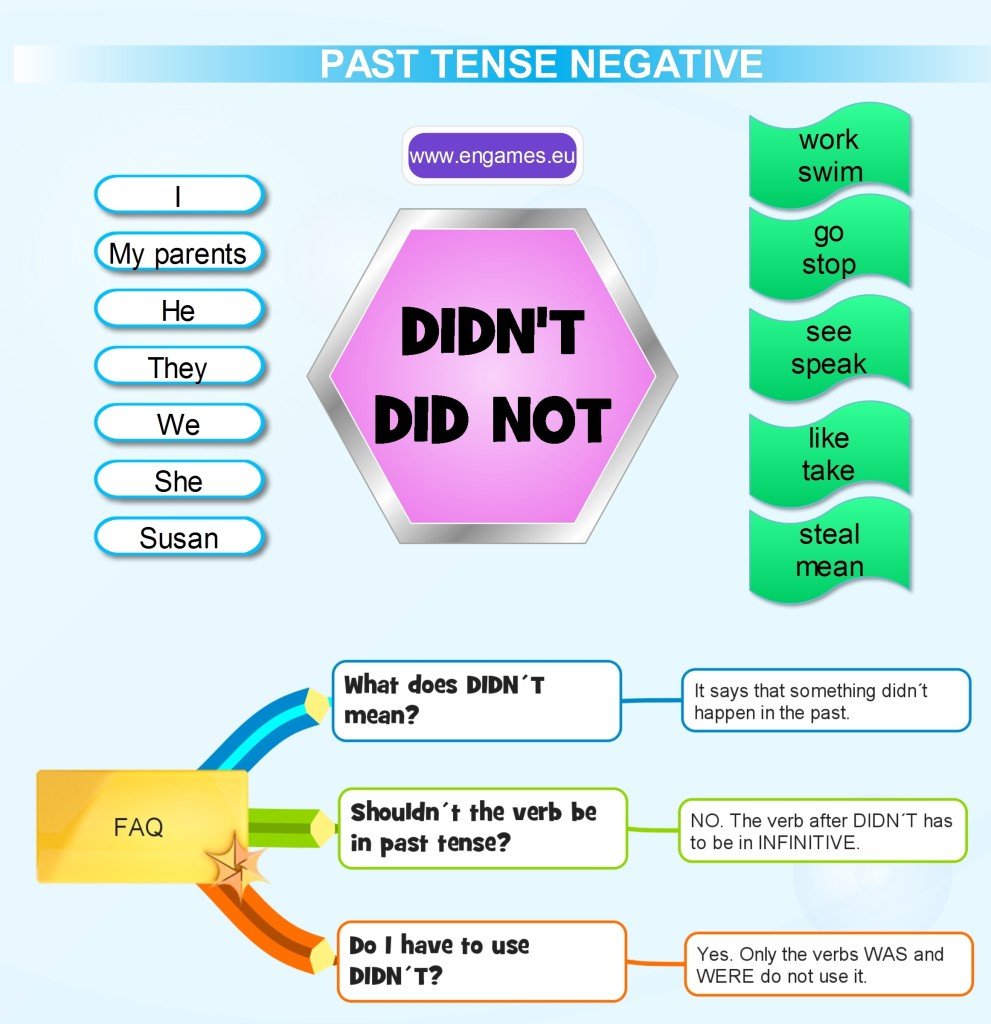
If you are a teacher it might be a good idea to let the students deduce the rules and complete the table. However, beware that this way of teaching is not suitable for weaker students.
ADVERT:
[showmyadsa]
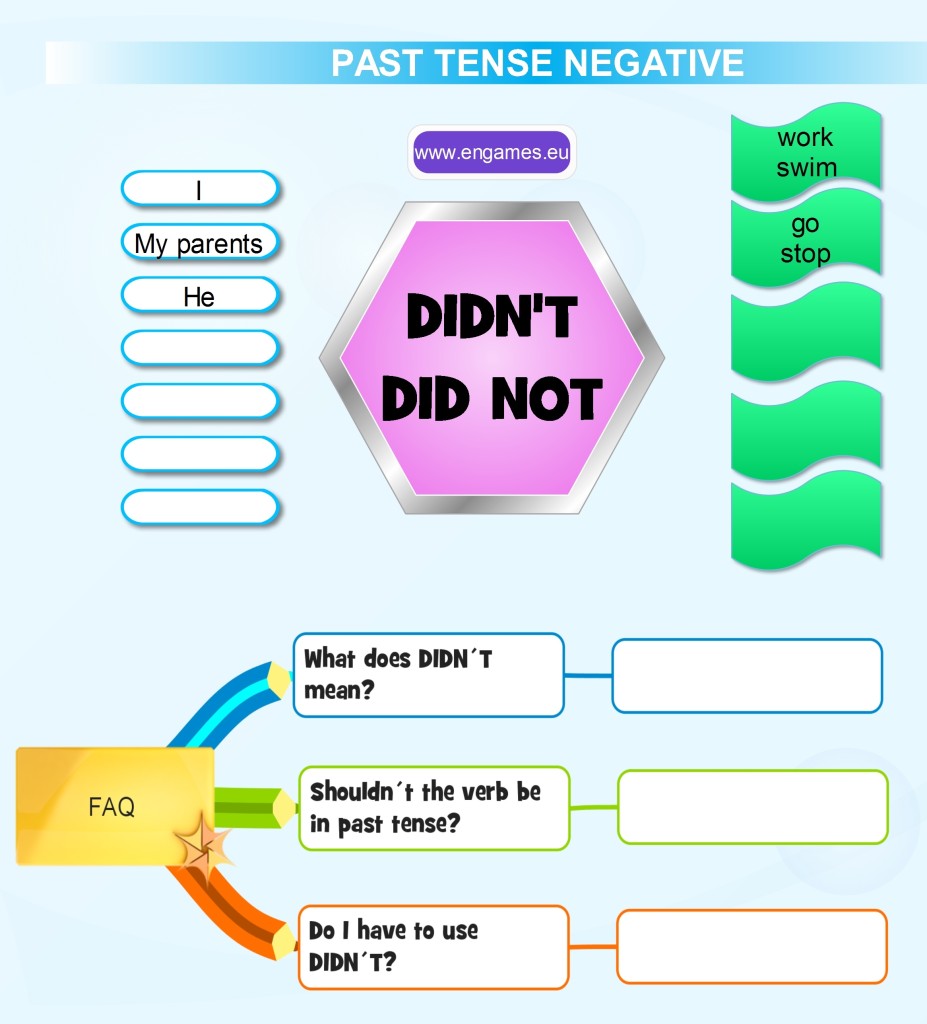
Past tense negatives – games
The first game is in HTML5. Your task is to choose the correct form and if you pass the test you will play the game called Tower defence. This game will play on all mobile devices.
If you want to play the game on the full screen, click below:
Past tense negative – Tower defenceThe second game will play only on your desktop. It is called a Penalty Shoutout and once you choose the correct option you will get a chance to kick a penalty. Will you score all ten penalties? Good luck.
Past tense negative – Penalty shootoutTeaching of past tense always starts with the verbs was and were, and then the regular verbs are introduced. And in the end, the students learn that there are over 200 irregular verbs which they have to learn. I have posted several articles on irregular verbs and on past tense in general. However, this is the first article that deals with regular verbs only.
ADVERT:
[showmyads]
In this post I would like to explain all the grammar about regular verbs in a mind map and then there are three games to practise the past tense of regular verbs. I hope you will find the article interesting and useful.
Regular verbs – Past tense – Mind map
Then the mind map shows the top ten regular verbs in past tense and then there is the explanation of the pronunciation.
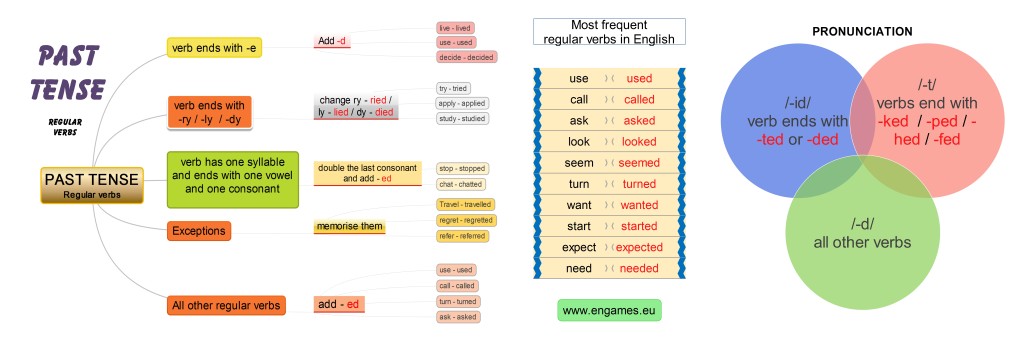
The mind map does not explain only one thing. How do you know that the verb is regular?
There is just one answer to this question. You have to learn all the irregular verbs and then all the verbs that are not irregular are regular. 🙂
Regular verbs – Past tense – Games
[showmyadsa] The first HTML5 game is called Tower defence. Your task is to write the past tense of all the verbs and if you pass the quiz you will be given a chance to play the game called Tower defense. Once you lose the game, please do not play again, as you will never win the game again. You have to take the test again and only then you will have a chance to win.
To play the game on the full screen please click below:
Regular verbs – Tower defense
In the second HTML5 game you have to put the verbs in the story into the correct form. I hope you will like the stories 🙂
To play the game on the full screen please click below:
Regular verbs – Angry Farmer
The last game is in FLASH and it will play only on desktops. It is called Hoopshoot and your task is to choose the correct form and then score a basket.
Regular verbs – HoopshootI have changed jobs and now I teach at elementary school. And even though I think that I am an experienced teacher I have never taught students with actual learning problems. Now I do, and I face real challenges. For example, this week I taught the verb HAVE GOT from the Project 1 textbook, and I failed to teach anything at all. When I asked my students to complete the green table with the correct forms, there was no reaction. And when I asked them to transform the affirmative sentences into negative ones, there was just one student who could do this.
ADVERTISEMENT:
[showmyads]
At that moment, I realised that I have to teach them differently. So I created the following materials to help my students learn to use the verb HAVE GOT in affirmative and negative sentences. I hope I will be more successful this time, and that you will find these materials helpful too.
HAVE GOT – visual presentation
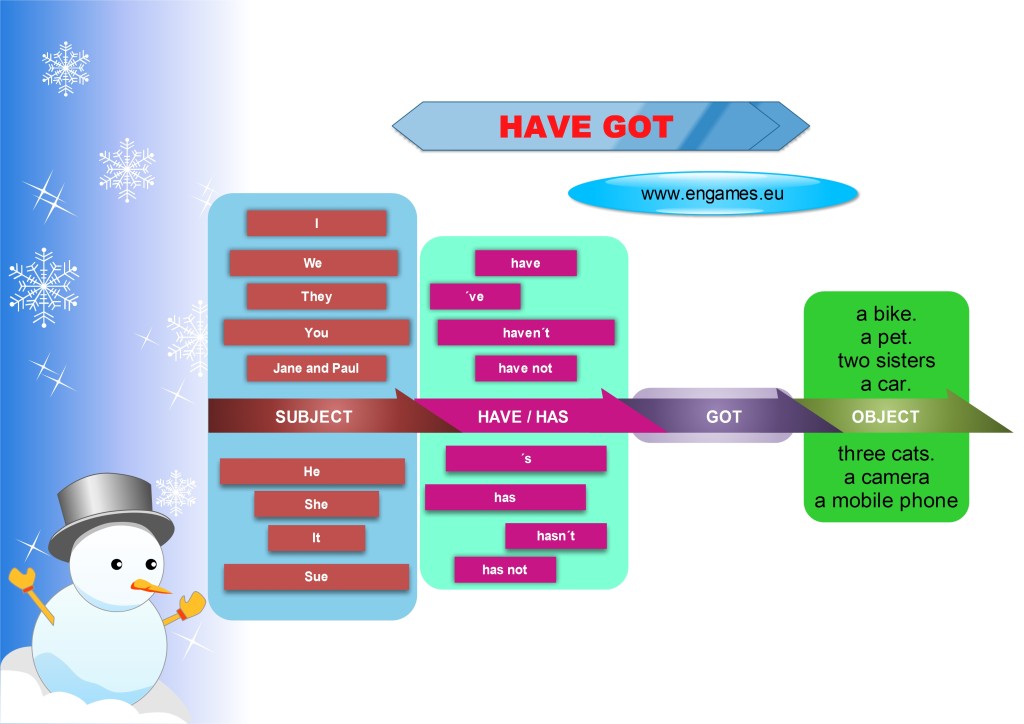
As I write above, table like this was very good for talented students but not for the pupils with learning problems. They need something else. But what?
When we wrote a test on vocabulary 75% of them were able to learn all the words correctly. So why not teach them the verb and its forms as a vocabulary item. No fine deduction just a crude memory work. I believe that is the way. So I have created the following graphical presentations.
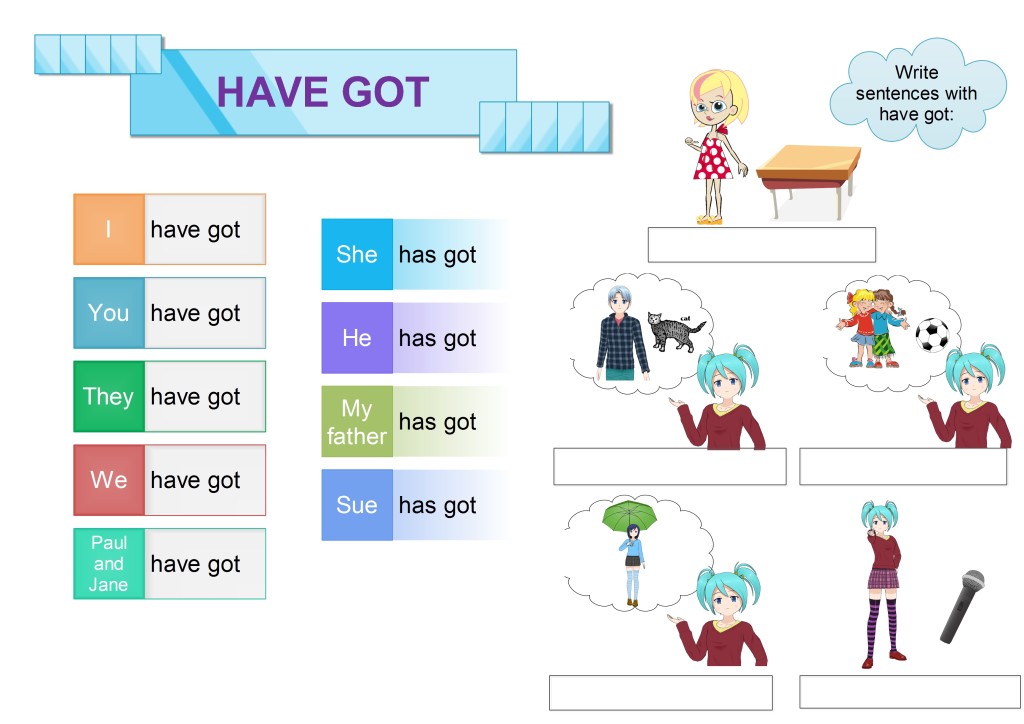
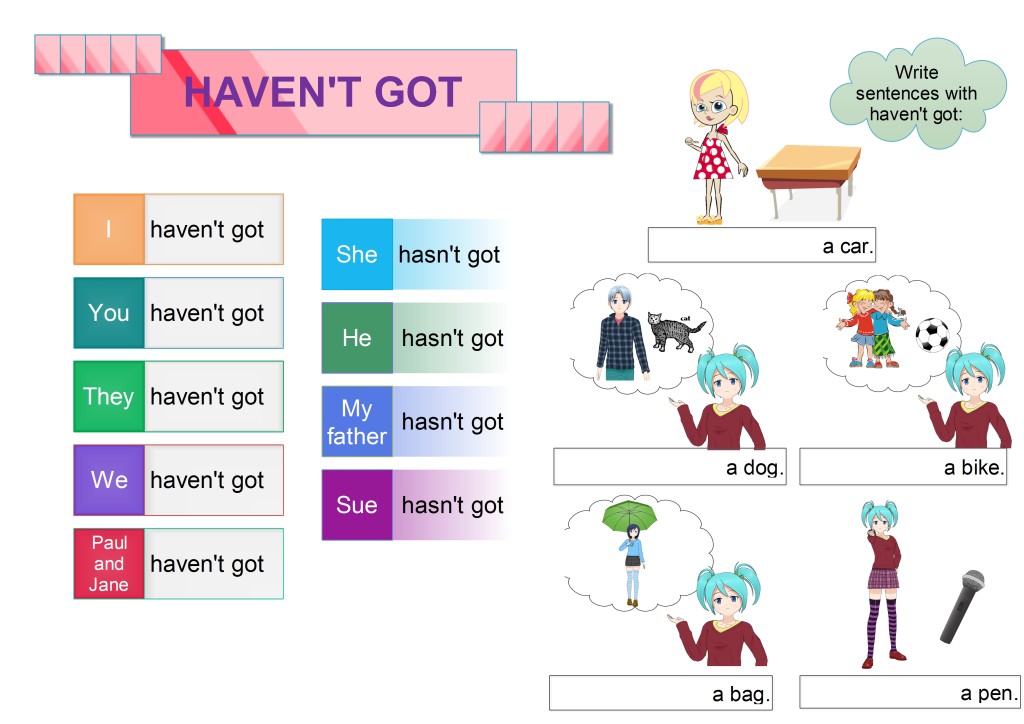
Ask your students to learn the forms by heart. Then ask them to use the phrases and write sentences to the pictures. If this proves too difficult write the five sentences randomly on the board and ask them to match them to the pictures and copy them.
Work in the same way with the negative sentences. In this way the students might comprehend the logic behind the forms or they will just remember the phrases and thus be able to use them.
HAVE GOT – classroom practise and worksheets
The first activity is called MT Board. I have create the following worksheet. At the top there is a table with the mother tongue sentences (the sentences are in Czech, so you have to change this one if you are not Czech). Below it there is the same table with the English sentences. Cut the English sentences along the lines and leave the mother tongue board intact. Ask the students to work in pairs and give them the Mother Tongue board and the English pieces. Ask them to place the pieces on the
board. Check their answers.
Board_push_have got
ADVERTISEMENT:
[showmyads]
The second activity is called a pair card. Print out the following worksheet and cut it in the middle (from top down not from side to side). Ask the students to work in pairs. Each student gets 8 completed sentences and 8 sentences with gaps. Students read (they must not write anything) their gapped sentences and complete them with the correct forms of the verb HAVE GOT. Their partner listens and checks or corrects their answers (He/she has the full sentences). Once they finish they can swap their cards and start again.
The last classroom activity is a drill. Once you feel that your students got the hang of the grammar, you can play the following recording. The native speaker will say the subject and the students have to supply the correct form of the verb HAVE GOT in the pause. Each pause is followed by the correct form and another subject.
To download the file, right-click the following link and choose the option SAVE AS…Have got_mp3 drill
HAVE GOT – Games
The game is called Basketball. This game is in flash and it will play only on your desktop.
Your task is to choose the correct form and then score a basket. Have got – basketball
In my latest post on irregular verbs I tried to teach 33 irregular verbs. In this post, I would like to add other 30 verbs which I hope you will learn through either the associative method or by using the spaced mp3 recording.
ADVERT:
[showmyads]
Irregular verbs – associative method
Look at the picture. There are the verbs with pictures and under each of the forms, there are two cells. Complete the cells with words in your mother tongue (or any other language you know) which are similar to the English words. For example: RODE – óda, rod RIDDEN – rýt, den. Don´t be afraid to split the words or jumble them. Write each of your associations into the cells and then you will see that it is much easier to remember the words.

You can download all the worksheets for all the 30 irregular verbs in pdf here:
Irregular verbs_part2
Irregular verbs – Random repeat
Listen to the recording and in the pauses try to say the past tense and the past participle of the given word.
ADVERT:
[showmyads]
If you want to listen to all the verbs again and again you can use the following recording:
If you want to download the files and listen to them for example in your car you can do this here:
Irregular verbs_part2 Random repeat recording
Irregular verbs_part2 listening mp3
Irregular verbs – games
To have a better experience on a mobile device, we recommend that you play it on a full screen. Click below
In the second game you should complete the sentences using the correct verb. If you pass this quiz you can play the game called Indiara. Good Luck!!!
Once again if you view this post on a mobile device, use the full screen mode by clicking the button below.
Irregular verbs – Indiara full screenI have already published several posts on irregular verbs: Past participles – divided according to the pronunciation and Present perfect tense. However, a week ago a student of mine contacted me and asked me if I could create a way for him to learn the irregular verbs. He spends a lot of time driving so he asked me to prepare something to listen to in his car. So I did. In this post there are 33 irregular verbs presented in an associative matrix, in mp3 for listening, in mp3 for learning and two games for practising them.
ADVERT:
[showmyads]
Irregular verbs – learning
Here you can find two ways to learn the irregular verbs. I have tried both and both work. The first one is called associative learning and you should write two words in your mother tongue under each verb. The words should be similar to the English words and at the same time they should emphasize the differences between the forms. For example Drive – Dr, Iveta DROVE – Dr., ovce, DRIVEN – Dři, venku. Create your own associations and you will see that you will know the verbs quickly.
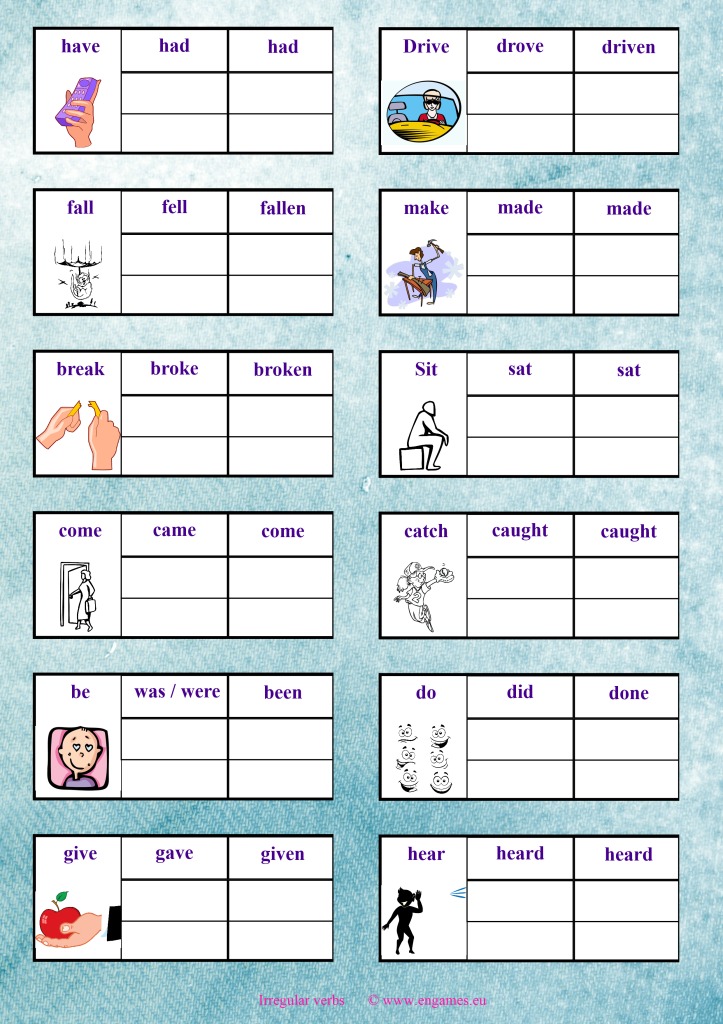
Here is the pdf version of all the irregular verbs:
Irregular verbs – Listen and learn
In learning there are only a few methods which work for everyone. One of them is called Random repeat. You are presented with something new and then after a short time you are tested. Then another new thing is presented and you are tested again. This is repeated several times and at the end you know a lot. You can try this method here. You will here three irregular verbs and then you will hear just the infinitive and you have 3 seconds (quite a lot of time actually) to supply the past tense and past participle. After the three seconds you will hear the correct answers and another verb. I hope it will work for you:
If you need just the correct pronunciation of each of the verbs presented above, here is the mp3 with all of the verbs:
You can download the files here:
All the irregular verbs
All the verbs learning mp3
Irregular verbs – games
Once you believe that you know the irregular verbs, it is time to practise them. Here there are two games for your mobile phones to practise the irregular verbs:
If you want to enjoy the game on the full screen click on the button:
Irregular verbs – Tower defenceIn the second game you should fill in the sentences with the correct words. If you pass the test you can play the game called Math pop and practise your maths at the same time.
If you want to play the game on a full screen, click the button below:
Irregular verbs – Math pop
You can find several online exercises at our new site grammarlane.com to practice irregular verbs.
There are some words you cannot live without in any language, and greetings certainly belong among those words and phrases. In this post I aim at introducing and teaching nine basic greetings for elementary students. To achieve this goal I there is a nice mind map and several games to practise these words.
Greetings – mind map
In this mind map there are the basic greetings ordered according to their frequency in British English. So the most frequent word in British English is “HI”.
ADVERT:
[showmyads]
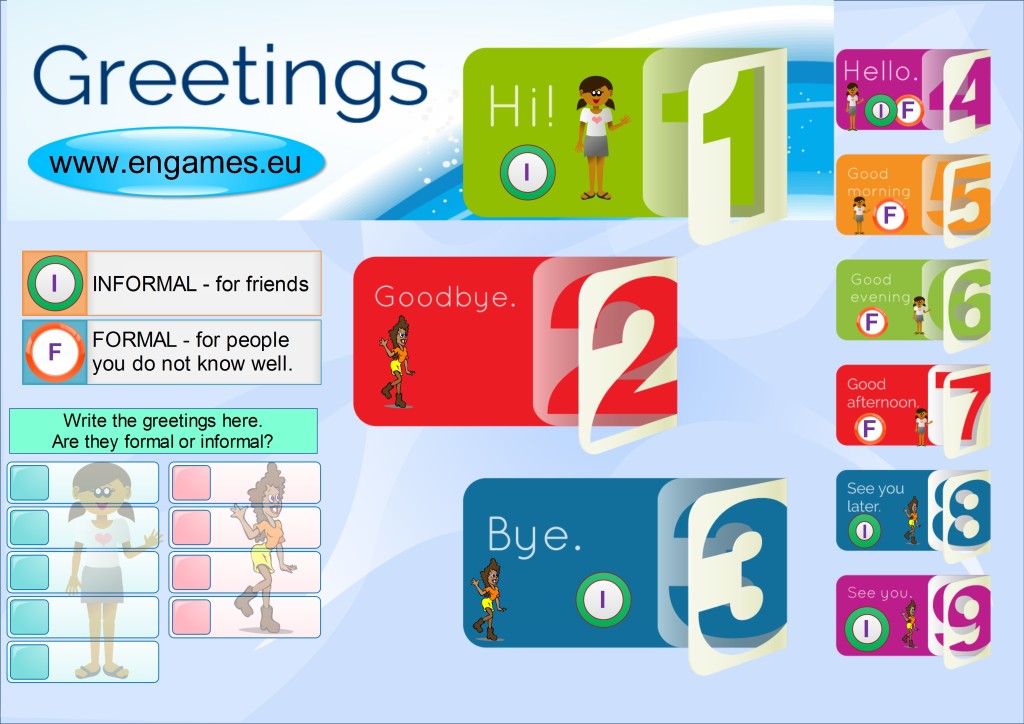
The letters in the circles show how formal or informal the given expression is. If it is informal we use the greeting with people we know well and our friends. With other people we use the formal greetings.
Notice that HELLO is both formal and informal. This greeting is often used instead of GOOD MORNING etc. and no one thinks you are being impolite.
Greetings – games
It is time to practise the greetings and learn them. The first game is in HTML 5 and it will play on any mobile device you use. It is a simple crosword. Click on any square and at the top of the crossword there will appear a clue. Then just type your answer. You can print out the crossword too and then solve it on a paper. It is up to you:
The other two games are in Flash and therefore they will play just on your desktop. The first one is called Teacher invaders and you have to answer all the questions with the correct greeting and then shoot all the invaders. Good luck.
The second game is called half a minute and it is suitable for classes with an interactive whiteboard. When you start the game there will appear the jumbled greeting and students have to write it on their paper and then one of them can type it into the computer. However, you have to do this in 30 seconds. Have a good fun with it.
SVOMPT rule is one of the most important rules in English. If students learn to follow this rule, their English will improve dramatically, and they will be understood. Once a student knows some words and follows the SVOMPT rule, we can say that he/she can speak English.
ADVERT:
[showmyads]
I love Darren Crown’s explanation of the origin of the SVOMPT word order. In his humorous book “Angličtina na rovinu” he writes that English was first used by a primitive tribe whose members did not want to use their brain too much and thus they created a word order which is always the same – Subject, Verb, Object, adverbs of Manner, adverbs of Place and adverbs of Time. So let´s stop looking for some complicated explanations and let´s think like the primitive barbarians and stick with the SVOMPT word order.
SVOMPT – mind map
The path shows the way an affirmative English sentence is created. You start with a Subject at the top and then you go down and add the words according to the SVOMPT rule.
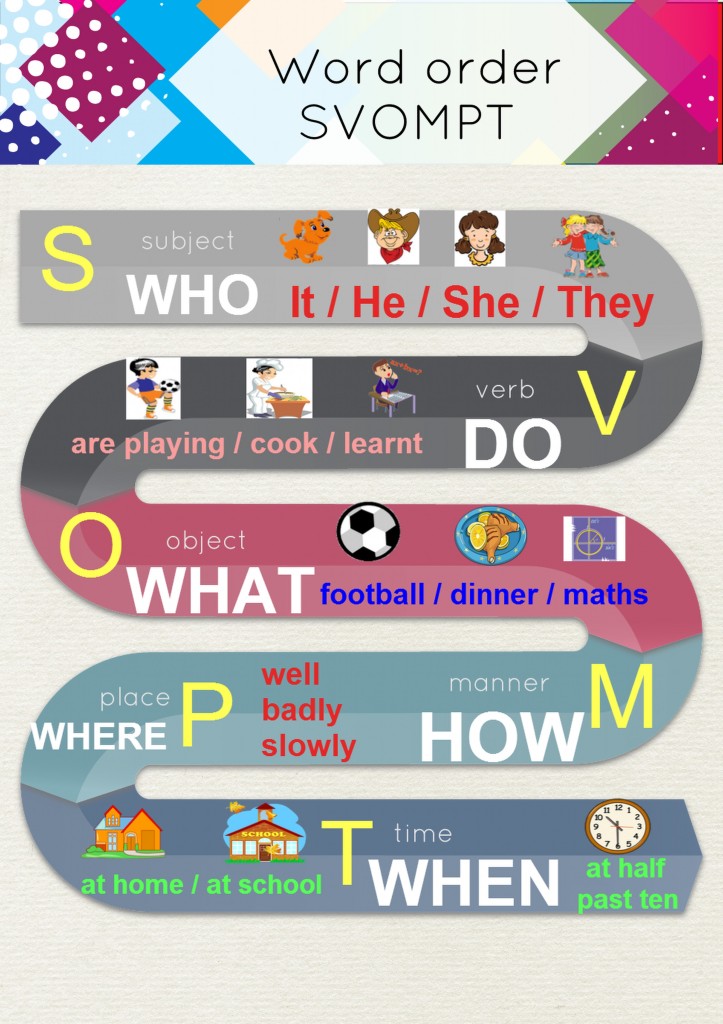
SVOMPT – games and quizzes
At the moment you feel you understand the grammar it is time to put your knowledge into practice. First, to be able to follow the rule you have to know what part of speech a given word is. You must know whether it is a Subject, Verb, Object, adverb of Manner, adverb of Place or adverb of Time to place the word into the correct place in an English sentence. To help you with this, you can try the following quiz where your task is to tell what part of speech a given word is. If you pass the test, you can play the game Angry finches.
If you want to play the quiz on the full screen, click on the button below.
In the second quiz your task is to put the sentence into the correct order. If you pass this quiz, you can improve your vocabulary in the game called Word Boggle.
If you want to play the quiz on the full screen, click on the button below.
Both games and quizzes are in HTML5 so they should play on all mobile devices.
Have you tried our vocabulary placement test for elementary students, and it was too easy for you? Have you scored close to 2000? Then this is the vocabulary test you should take. Here we test the words which belong between 2,000 and 5,000 most frequent words in English.
ADVERT:
[showmyads]
There are 60 questions and the score at the end tells you how many words from the 3,000 words you know. If you add this score to the score from the test for elementary students, you will know how many words from the five thousand most frequent words in English you know.
Vocabulary placement test – test
Give a try to the following test. The score at the end of the test tells you how many words you know. So if it tells you that your Score is: 2,350 points it means that you know 2,350 out of the 3,000 words which belong into the group of 2,000 to 5,000 most frequent words in English.
If you want to do the test on the full screen, click the button below. The test is made in HTML5 so it will play on your mobile phones as well:
Vocabulary placement test – full screen
If you want to know the total number of English words that you know among the 5,000 most frequent words in English take the Vocabulary test for elementary students and then add the score to the score from the test above. Thus if you score here 1,750 and in the elementary test 1,800, you know 3,550 words from the 5,000 most frequent words in English.
Remember, THE MORE ENGLISH WORDS YOU KNOW THE BETTER YOUR ENGLISH IS!!!!
Vocabulary placement test – comment
Please, if you spot a mistake, or you come up with a better definition, please leave a comment. We are trying to improve each activity, and your comments help us a lot.
Thank you.
Students like reading comics. Comics are often the only thing students read. When I started an extensive reading project last year, students did not mind reading comics, however when we moved to short stories, more than half of them stopped reading and started to hate the programme. On the basis of this experience I have prepared a fairy tale comic for students to read.
ADVERT:
[showmyads]
To be able to read a text and understand it, it is essential that you know the words. The more words you know the more you can enjoy the text. That is why I have so many materials dealing with the vocabulary here. First, learn the vocabulary with our associative method and then play the games. Once you know the words, watch the video and answer the comprehension questions.
Jack the Giant killer – vocabulary
First, learn the vocabulary using our associative learning method.
Associative learning method
When I study vocabulary, I am able to learn about 50 words a day. And here is how I do it.
The Associative learning method.
Take each word and find in your mother tongue or any other language you know some words it reminds you of. Thus for example, when I see the word GIANT I come up with these associations: Gigantic, Gigi (my former student´s nickname, anténa (antenae). When I create these associations I move to another word. I go on like this with four words. Then I cover the English words and I see just their translations and I recall them.
In this way I go on for as long as I feel like it and my vocabulary grows.
Vocabulary activities
Here are the words and materials to learn them using the associative method. You can verify your knowledge of the words at the end where there are two quizzes. If you pass the test you can play a game. All of the activities are in HTML 5 so you can learn using your mobile whereever you are.
For a better mobile experience it is better to click over here and see the activity full screen.
Vocabulary – associative method
If you prefer doing these activities offline, you can print out the following worksheets and try them out:
Word games_part01_giant
Giant_page_pdf – associative method worksheet
If you like crosswords on your computer, you can try the following one. It is in HTML5 so it will play on all mobile devices too:
Jack the Giant killer – crossword
Jack the Giant Killer – video
Now, that you know the vocabulary, you can watch the first part of the video and enjoy it.
And now try the comprehension quiz. If you pass the quiz you can play the game called HOT RACE. The quiz is in HTML 5 so it will play on any mobile device. However, the game is only in Flash and it will play on your desktop only.
If you want to play the quiz on full screen, click the following button:
Comprehension questions – part 1
Associative learning method – comments
- How did the method work for you?
- How many words were you able to learn this way?
- What problems did you encounter?
- Is there anything more you would like to tell us?
Do not hasitate and comment below. Thank you 🙂
Recently we have published a placement test based mostly on grammar. Some of our readers commented that a vocabulary placement test might be useful too. That was why we have tried to create a test which would show you how many words you know. A part of the test is partly based upon the test by Paul Nation, however the first part is completely original.
ADVERT:
[showmyads]
This test is for beginners and elementary students of English. Here you can find out, how many words from the 2,000 most common words in English you know. So, if you answer all the questions correctly, you know all the 2,000 most common words in English. If you answer only 50% of the questions, you know 1,000 words. Your aim is to score as much as possible.
Vocabulary placement test – beginners
The following test contains 60 items. Your task is to drag the most suitable word to a given picture or into a given gap. You can guess because there are many extra words which make correct guessing virtually impossible. Once you finish the resulting score tells you how many words you know.
If you want to do the test in a full-screen mode click over here for the HTML5 version:
Placement test vocabulary HTML5
If you want to do the test on your computer and you prefer flash, click on the button below:
Placement test vocabulary flash
If your score is close to 2,000 it is clear that you know more words. If you want to find out how many, you can try our Vocabulary placement tests for pre-intermediate and more advanced students (coming soon on this website.)
Vocabulary placement test – share
If you have a website where you would like to share this test, you can embed it there by placing the following code into it:
<iframe src="http://www.envocabulary.eu/placement test/Vocabulary placement test_beginners (Web)/index.html" width="560" height="500" frameborder="0" allowfullscreen="allowfullscreen"></iframe>
Vocabulary placement test – comments
We welcome any comments you might have, because they help us improve the posts here. We try to implement your comments into the activities immediately and we try to answer them. For example, there are nearly 20 comments to the Placement test post and thanks to you we were able to improve several questions, so now the test is much more reliable than it was before. Therefore do not worry and comment. THANK YOU.
Our most popular post is about questions with HOW. There is another post on all the WH question words. In this post I would like to deal with the questions starting with the word WHAT. To help you with this grammar there is a mind map and two games.
ADVERT:
[showmyads]
Questions with the word WHAT – mind map
The mind map shows the most frequent usages of the word WHAT in questions. What is most frequently followed by IS/ARE. Another possibility is, that it is followed by a NOUN. The most common nouns after the word WHAT are colour, kind of, sort of and time. And the third option is that the word WHAT is followed by DO/DID.
There are three set phrases which you should learn by heart: What happened? What is he like? and What does she look like?
The mind map clearly shows the usage of the word WHAT and it is designed in such a way that it can be used as a worksheet too. Your task is to write 10 correct questions starting with WHAT there.
Questions with the word WHAT – games
The first quiz and game in one has been designed in HTML5 so you can play it on any mobile device or a computer. Your task is to answer the quiz questions and if you pass the quiz, the game Word boggle is waiting for you. Your task is to find in 30 seconds as many words as possible. The longer the word the more points you get. At the end you can share your score on Facebook or here in the comments section. Good luck.
If you are using a mobile phone click here, to see it on the full screen.
Questions with WHAT – Mobile quiz
The second game is in flash and it will play only on desktops. It is called Penalty and your task is to answer the questions and score. Could you be a professional footballer?? 🙂
I have already dealt with the usage of prepositions in the posts Prepositions AT, IN and ON for time and Adjectives with prepositions. However, this post is different because it concentrates only on the phrases IN THE END, AT THE END, IN TIME and ON TIME which are frequently used incorrectly by students of English. In this post I would like to explain the usage and meaning of the phrases. To achieve this I have created a mind map, an interactive video and two quiz games.
ADVERT:
[showmyads]
Set phrases – mind map
In this mind map I try to explain the meaning and the usage of the phrases IN THE END, AT THE END, IN TIME and ON TIME.
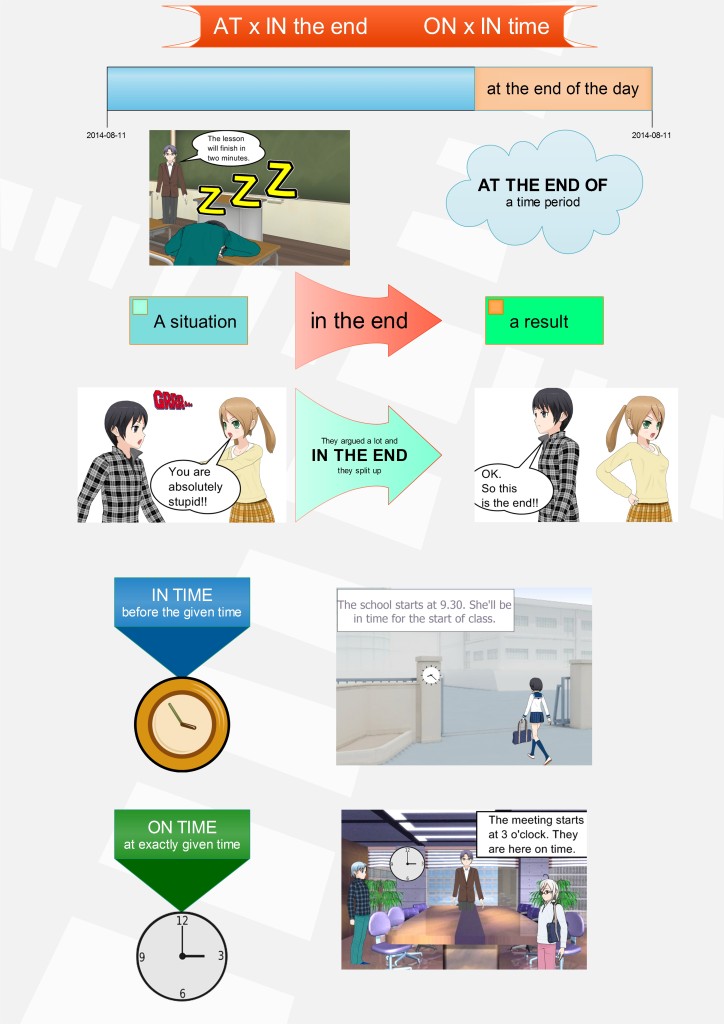
If you feel that this explanation is not clear enough, there is a video explanation which can help you.
Set phrases – interactive video
In this interactive video you can see and here the explanation of the usage of the phrases. The video contains many questions which you have to answer to move on. In this way you can check immediately whether you understand the phrases and use them correctly. The video is in HTML5 so it will play on your mobile device too.
Set phrases – games
Now, I hope, you understand the usage and meaning of the phrases IN THE END, AT THE END, IN TIME and ON TIME. So do not hesitate to try out our interactive exercises and games. The first game is in HTML5 and it will play on any mobile device.
Your task is to complete the quiz with the correct phrases and if you pass you will be given a chance to play the game Word boggle (really great addictive game which might help you improve your English a lot).
The second game will play only on your desktop. It is called Hoopshoot and your task is to choose the correct answer and then score. Good luck.
Means of transport is one of the topics you cannot avoid. Nowadays people travel a lot and they often have to do it on daily basis. And thus it is one of the most natural topics for a conversation in a class. Here you can learn the names of several means of transport and you can learn to speak about them fluently. To help you achieve this there is a mind map, a video, several worksheets and two games.
ADVERT:
[showmyads]
Means of transport – song
Start the lesson with the following song. It is fun and you can ask your students to count how many different means of transport they heard in the song:
The correct answer is 13.
In the following exercise, you can try listening again and tick all the means of transport you hear.
Means of transport – vocabulary
After introducing the vocabulary, it is time to learn it. The following worksheet contains three activities for you. There is a crossword, a spiral crossword and a set of jumbled words. Print the worksheet out and try to complete the activities.
Means of transport – worksheet
If you are a teacher, it might be a good idea to include the BINGO game in your lesson. There are 18 different BINGO cards for you to print out. You can either call out the words yourself or you can ask your students to write 3 sentences which contain one or two of their words. Then each student reads one of their sentences and the others cross out the words they hear. Do not forget to set the winning combination before you start the game.
Means of transport – BINGO cards
Means of transport – mind map
This part is the most difficult one. While the previous activities were for elementary students of English, this one is more suitable for pre-intermediate and intermediate learners. Print out the following mind map and then watch the video and complete it.
At the end of the video there is a task to speak about the given topics for the set times. You can, or better you should, use your mind map with your notes. If you can speak about the means of transport, the following games will be a piece of cake for you.
Means of transport – games
The first game is quite easy. Complete the quiz and if you pass you can play the game called Tower defence. The game and the quiz are in HTML 5 so they will play on your mobile device.
Means of transport – Indiara game
The second game is slightly more difficult. Your task is to complete the sentences from the video, so if you are not sure what there was, play the video on means of transport again. If you pass the test you can play the Indiara game. Good luck.

